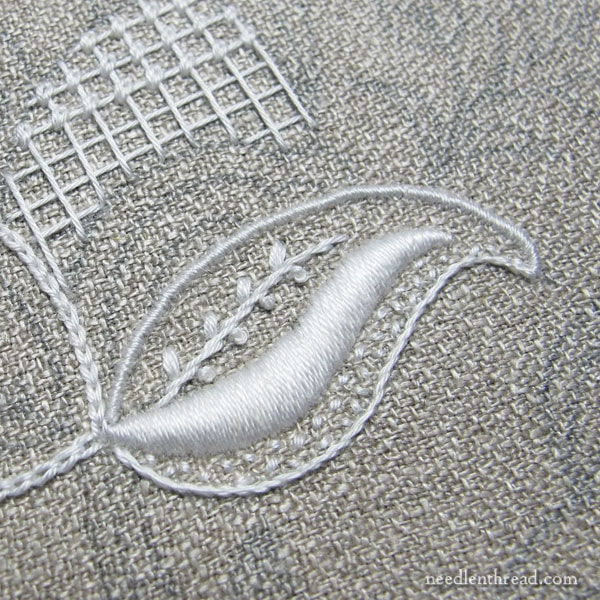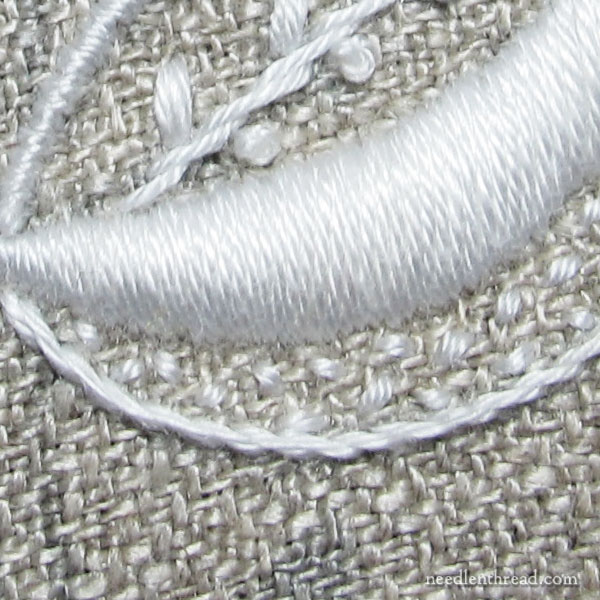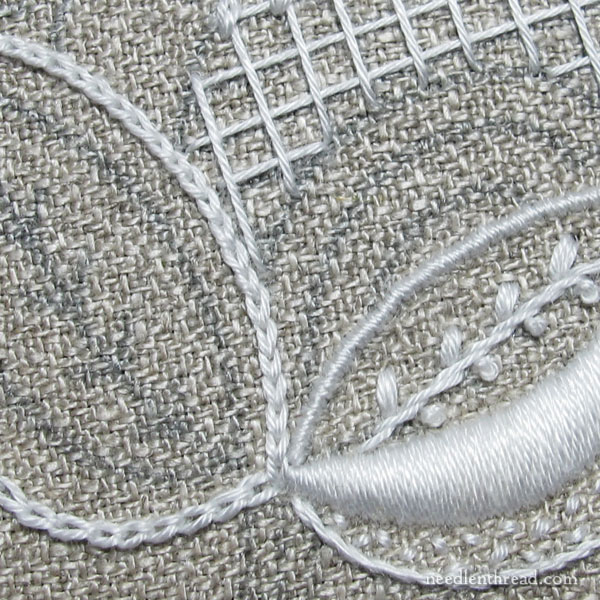Some people say you can embroider on anything.
And I agree, to an extent.
But that doesn’t mean that you shouldn’t pay pretty close attention to the ground fabric you select for your embroidery projects. The ground fabric (the fabric you are stitching on, that the embroidery is embellishing) has to work with the type of embroidery you’re doing, or there’s no sense in using it.
I’ll give you one small example of a selection I made for a ground fabric that I thought about using, but changed my mind. And I’ll show you why I changed my mind. And hopefully, the conclusion we can draw is that you have to consider what you’re stitching and what techniques you’re using when you select fabric, so that the fabric you select will work for you.

When I first started toying with my Jacobean Whitework idea, I thought about using a dark, natural colored linen – specifically, this linen crepe that I wrote about last year.
I like this fabric. I think it would fantastic monogrammed hand towels!
But as I toyed with it, playing with the design I’m stitching on a completely different fabric now, I found myself second-guessing my decision to use it.

I was pleased enough with the smooth edge I could accomplish with the satin stitch, despite the irregularities of the cloth’s weave.
The split stitch outline and the padding under the satin stitch go a long way to make the smooth edge possible. The weave tended to make my eyes go a little wonky when I was trying to place my stitches. If it hadn’t been for the split stitch outline that I was using to guide my needle, I don’t think my edges would have come out quite as decent as they did.
I found the overcasting on the top outline of the element in the photo above a little more difficult to keep smooth. I didn’t have the firmness of a split stitch line guiding me while doing the overcast stitch. I just had a loose string to stitch over.
But the difficulty here isn’t really the satin stitch and it isn’t really the overcast stitch.
It’s the seed stitching.
Seed stitch is often an integral part of whitework. It’s used to add texture and a light filling to an area.
With the linen crepe, because of the irregularity in the weave, the seed stitching practically disappears into the cloth. It doesn’t provide texture, that’s for sure. The fabric itself overwhelms it. The way the light glints on the linen fibers in the fabric make the seed stitches somewhat hard to distinguish against the fabric. If I had not been using white threads, the seed stitching would show up better, but with the white on the natural, it doesn’t work so well.

I like the crepe. I want to stitch a regular surface embroidery design – in color – on it. But for the design I had in mind – which is this Jacobean Whitework thing I’m working on blue linen at the moment – it didn’t strike me as the best choice of fabric for the type of stitching I was going to be doing.
The Take Away
When you are choosing ground fabric for an original embroidery project, keep in mind the type of stitching you’ll be doing on that fabric, and decide whether or not the fabric will show off the stitching to the extent that it really should.
The whole point of the ground fabric is to enhance the stitching, because really, the stitching is what the project is all about. If your fabric takes away from the stitching, it isn’t the best choice.
How can you know if your fabric will work? Well, if you’re toying with the idea of using a fabric you aren’t sure about, your best bet is to stitch a small sample first. If there’s any particular technique that you wonder about – will this fabric work with that type of stitching on it? – stitch that particular technique as a sample. You’ll really only know once you try it. And it’s better to try on something small than to set up the whole project and just expect that you’re going to love it.
Coming up on Needle ‘n Thread & News
This weekend, I’ll be making a little more progress – if the stars are correctly aligned, I guess – on my white-on-blue Jacobean whitework. Whatever happens, it has to be better than last weekend’s stitching debacle!
We’ll explore some tips and techniques and general information about whitework in the coming weeks.
Floral Corner Towel Sets are Back!
For those who wanted some pre-transferred flour sack towels with the Floral Corner designs on them, there’s a limited quantity back in stock and you’ll find them here in my shop. I’ll probably make up more down the road, but it will be a while. I’m sprinting ahead on a couple other projects and the towels are unfortunately Too Much Mess!
I hope you have a terrific weekend!







I think white is very elegant on that fabric. Have you tried it with white wool?
The crepe is one of my favorites!
I want to do a birth record embroidery for a wall hanging and need to choose a fabric. I have done a kit with twill fabric that worked well (unknown fiber content). Would I need a linen twill, or is just a regular linen okay?
Your website is SO helpful! Thank you for your willingness, and time, to teach embroidery.
Either will work for surface embroidery, but if you’re doing surface embroidery, you’ll want to make sure the linen you choose is a closely woven linen – the threads should fill the weave. You could use twill, though, if you wanted – it’s a great fabric to stitch on!
I to love the color of the crepe. What about french knots instead of the seed stitch?
I read this with great interest. I just did a large applique project that I embroidered heavily, but for the background I used…wait for it…a dark gray corduroy fabric. You see, when I started the project, I was on a “don’t buy anything new, use up what you have”streak — so when I stumbled across the corduroy, it seemed like a good idea. And actually I’m pretty happy with it, although I have a bit of the same problem that you’re having in that some stitches just disappear into it. I solved that by using heavier threads and yarns. Now I’m just starting the process of quilting it and I’m again using heavier yarns/needles than I normally would, but I’m actually liking the effect. Of course, the applique I’m doing also works well against the rustic corduroy. So not everyone will agree with me, but I do think it’s important to experiment and play around with the grounds. It may surprise you.